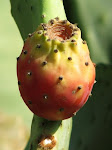On Monday, I went on a trip to Mount Hermon, the northest point and also the highest point in Israel. This mountain, within the region called the Golan Heights, is considered "the eyes of the state" for its strategic position - its height serving as a primary source of warning from possible neighbors' hostility acts. There's, of course, some army presence on the mountain equipped with the latest tracking system.
military post
In winter, the Hermon area, is a ski resort, the only one in the country. The ski site is operated by the people of the small settlement Neve Atib. There are in fact three inhabited places on the mountain: a druse town, Madged-El-Shams, a druse village, El-Kynia, and the jewish moshav (agricultural community) of Neve Atib.
Maged-El-Shams - the druse town
Now with the summer here, one could see only some very distant patches of snow on the highest peak of the mountain which is...on the syrian side of the border.
During summer, besides being a refuge from the scorching heat, the Hermon mountain area offers a variety of recreational activities:rock climbing, hiking, cable cars to climb up the mountain while having a view of the entire region, studying its unique flora and fauna, exploring its streams and waterfalls.
cable cars - up and down
flowers of Hermon
On our way back home, we just had to buy cherries. There's nothing like the cherries from the orchards of the Golan Heights.
cherries
>






















